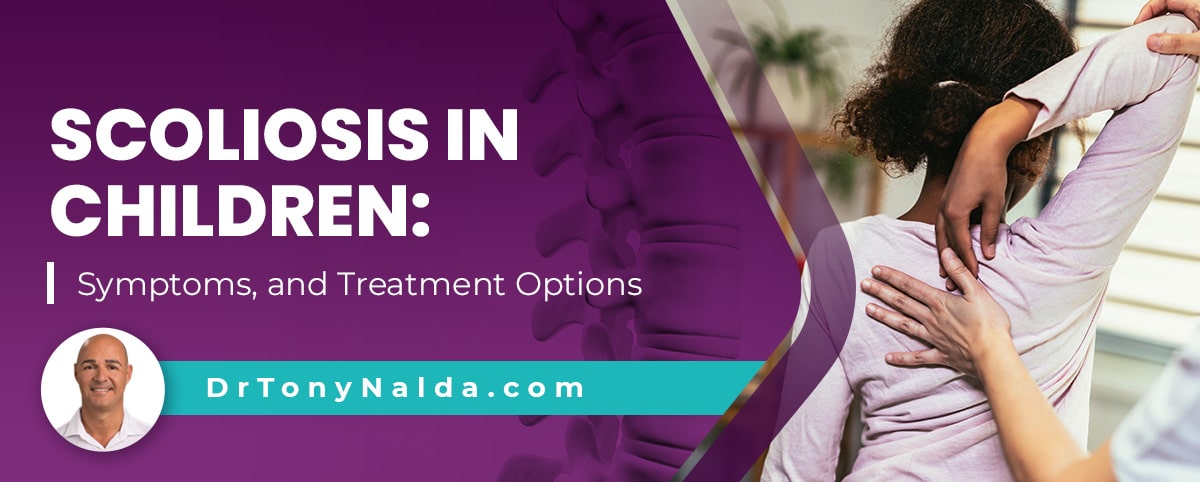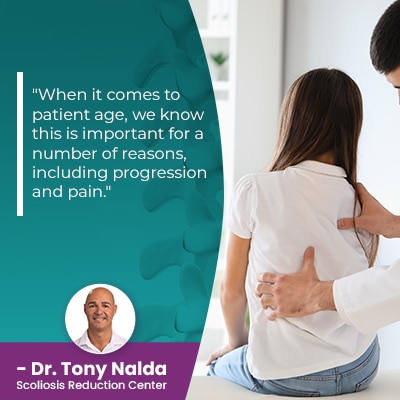Scoliosis in Children: Symptoms, and Treatment Options

As a progressive condition that's triggered by growth, scoliosis in children should be taken very seriously. The most common type of scoliosis overall is adolescent idiopathic scoliosis, diagnosed between the ages of 10 and 18.
Scoliosis is a progressive spinal condition that affects all ages, but it is most often diagnosed in children. The most common symptom of scoliosis in children is postural deviation, and treatment options include a surgical, or non-surgical treatment approach.
Part of diagnosing scoliosis involves comprehensively assessing conditions so they can be further classified, so let's start with how scoliosis is diagnosed and classified in children.
Table of Contents
Diagnosing and Classifying Scoliosis in Children
Diagnosing scoliosis in children isn't always easy.
While it might seem obvious when someone develops an unnatural sideways-bending spinal curvature that also twists, scoliosis ranges widely in severity, and when mild, the condition's effects can be subtle.
Scoliosis is also a progressive condition, so where a scoliosis is at the time of diagnosis isn't indicative of where it will stay; only proactive treatment can work towards counteracting the condition's progressive nature.
To diagnose scoliosis curves in children, most often, it's the parents and/or caregivers that notice a change in their child's spine and/or posture.
When many children are brought in to see me for a diagnosis, this generally involves taking the patient's medical/family history, and observing how they walk and hold themselves (posture); I can tell a lot about a child's spinal health by their gait.
Then I perform what's known as an Adam's forward bend test, and while the patient is bending forward, I examine their spine, and in this position, if the spine curves unnaturally and/or if there are postural asymmetries and rotation present, it's the most visible in this position.
When scoliosis is diagnosed, it's further classified based on key patient/condition variables that shape the customization of treatment plans: patient age, condition type, severity, and curvature location.
 When it comes to patient age, we know this is important for a number of reasons, including progression and pain.
When it comes to patient age, we know this is important for a number of reasons, including progression and pain.
Scoliosis is triggered by growth, so patients who are still growing are at risk for continued progression, and scoliosis doesn't generally become a compressive/painful condition until skeletal maturity has been reached; in fact, when it comes to adult scoliosis curves, the main symptom that brings patients in for a diagnosis and treatment is back pain, and pain that radiates into the extremities due to nerve compression.
Condition type is important and is determined by causation.
The most common type of scoliosis to affect all ages is idiopathic scoliosis, and idiopathic scoliosis isn't clearly associated with a single-known cause.
Approximately 80 percent of known diagnosed cases of scoliosis are classified as idiopathic scoliosis, and the remaining 20 percent are associated with known causes: neuromuscular scoliosis, degenerative scoliosis, and congenital scoliosis.
Severity is a key factor that treatment plans are shaped around, and scoliosis can range from mild to moderate and severe to very severe, and when it comes to curvature location, we're talking about where in the spine the curve develops.
There are three main spinal sections, and scoliosis can develop in any of them, or in more than one as a combined scoliosis: cervical spine (neck), thoracic spine (middle/upper back), and the lumbar spine (lower back).
Knowing the curvature location and the specific vertebrae that are the most tilted out of alignment with the rest of the spine helps guide where to concentrate my treatment efforts.
Scoliosis affects people, and children, of all ages, so let's start with the different types of childhood scoliosis, based on patient age.
Congenital Scoliosis
Cases of congenital scoliosis are rare, affecting approximately 1 in 10,000, and congenital scoliosis develops in utero, so babies are born with the condition.
Spinal malformations that can cause the development of congenital scoliosis can involve spinal vertebrae being more triangular in shape, than rectangular, as they should be, and when vertebral bodies fail to form into distinct and separate bones, instead becoming fused together as one solid bone, this can also disrupt the spine's ability to form natural and healthy spinal curves.
Congenital scoliosis patients have to be monitored and assessed closely for signs of other malformed parts and/or systems within the body, and cases of congenital scoliosis are treated with monitoring for progression, some casting when appropriate, and when severe, doctors can recommend surgery.
Infantile Scoliosis
Infantile scoliosis patients are between the ages of 6 months and 3 years old, and these cases are idiopathic.
Some cases of infantile scoliosis resolve on their own, but some progress with growth, and there is no way of knowing which cases will get worse with growth spurts and which won't, so it's important to be proactive.
Treatment for infantile scoliosis can involve gentle chiropractic care, physical therapy and corrective bracing, when appropriate, and treatment plans are modified to address the unique challenges of treating scoliosis in such young patients.
Early-Onset Juvenile Scoliosis
Early-onset juvenile scoliosis is diagnosed between the ages of 3 and 10 years old, and this is the age group that I can make the biggest potential impact with treatment; this is because the condition is diagnosed, and can be treated, prior to the first significant adolescent growth spurt.
While there are never treatment guarantees, early diagnosis and treatment does increase the likelihood of treatment success.
When it comes to symptoms of scoliosis in children, we're talking about postural deviation which can commonly include:
- Uneven shoulders
- Uneven shoulder blades (one shoulder blade sitting higher than the other)
- The development of a rib cage arch
- An uneven waistline
- Uneven hips
- Arms and legs that appear to hang at different lengths
In addition, changes to gait, coordination, and balance are also common, and in general, the more severe a condition, the more noticeable its effects are likely to be.
Adolescent Idiopathic Scoliosis
 Adolescent scoliosis treated early in the condition's progressive line is beneficial because it means treating scoliosis when it's the most likely to respond to treatment.
Adolescent scoliosis treated early in the condition's progressive line is beneficial because it means treating scoliosis when it's the most likely to respond to treatment.
Adolescent idiopathic scoliosis (AIS) is diagnosed between the ages of 10 and 18 and is the most prevalent form of childhood scoliosis and scoliosis overall.
This age group is the most at risk for rapid-phase progression because of the stage of puberty and its rapid and unpredictable growth spurts; remember, growth triggers scoliosis to get worse.
Scoliosis getting worse means the size of the unnatural spinal curve is increasing, and this means the spine is getting increasingly rigid, is going to be less responsive to treatment, and more complex to treat, which is why being proactive with treatment can be so beneficial.
Most cases of adolescent idiopathic scoliosis are diagnosed when moderate because the symptoms of mild scoliosis are subtle and difficult for an average person to recognize, but when scoliosis progresses into the moderate classification with a Cobb angle measurement of between 25 and 40 degrees, this is when the condition's effects tend to become noticeable.
Treatment for adolescent idiopathic scoliosis has the goal of correcting scoliosis by achieving a significant curvature reduction on a structural level and holding it there despite the constant trigger of growth.
Here at the Scoliosis Reduction Center, I offer patients a non-surgical conservative treatment response, and this involves integrating multiple specific treatment disciplines into customized treatment plans: chiropractic care, physical therapy, corrective bracing, and rehabilitation.
Conclusion
When a child has scoliosis, it's not always easy to recognize.
Scoliosis ranges widely in severity from mild to moderate and severe to very severe, and as scoliosis doesn't become a compressive condition until adulthood, it's not commonly painful in children.
When a condition isn't painful, that makes it more difficult to diagnose, and particularly when mild, the postural changes associated with scoliosis can also be subtle.
While traditional scoliosis treatment commonly funnels patients towards spinal fusion surgery, conservative scoliosis treatment offers a less-invasive treatment response that isn't associated with disruptions to long-term spinal strength and function.
There are different types of scoliosis and the majority of childhood scoliosis cases are idiopathic, meaning not clearly associated with a single-known cause, and the remaining 20 percent are associated with known causes: neuromuscular scoliosis, congenital scoliosis, and degenerative scoliosis (adult scoliosis).
When young adults are diagnosed with scoliosis, the most important decision to be made is how to treat it moving forward.
Whether scoliosis is treated surgically or non-surgically will shape a patient's long-term spinal health, and this is an important factor when it comes to quality of life (activity restrictions such as no contact sports are common with fused spines).
When treated proactively, scoliosis in children can be highly treatable, particularly if diagnosed and treated before a young patient's first pubescent growth spurt.
We don't often know what causes the initial onset of scoliosis in children, but we most certainly know what makes it progress: growth and development.
Scoliosis only gets more complex to treat the more it progresses, so the best time to start a child's treatment for scoliosis is always now, and not all cases of scoliosis require surgery.
There was a time when mandatory school screening for scoliosis took place across the United States, but that has since changed, so it's important for parents and/or caregivers to be educated on the common signs of scoliosis in children; it can lead to early detection and treatment success.
Dr. Tony Nalda
DOCTOR OF CHIROPRACTIC
After receiving an undergraduate degree in psychology and his Doctorate of Chiropractic from Life University, Dr. Nalda settled in Celebration, Florida and proceeded to build one of Central Florida’s most successful chiropractic clinics.
His experience with patients suffering from scoliosis, and the confusion and frustration they faced, led him to seek a specialty in scoliosis care. In 2006 he completed his Intensive Care Certification from CLEAR Institute, a leading scoliosis educational and certification center.
About Dr. Tony Nalda
 Ready to explore scoliosis treatment? Contact Us Now
Ready to explore scoliosis treatment? Contact Us Now





